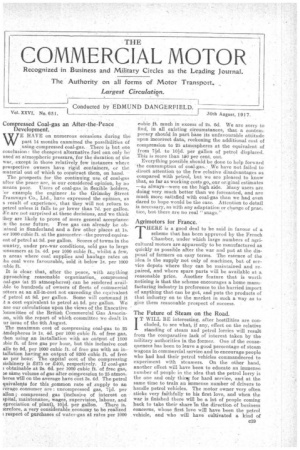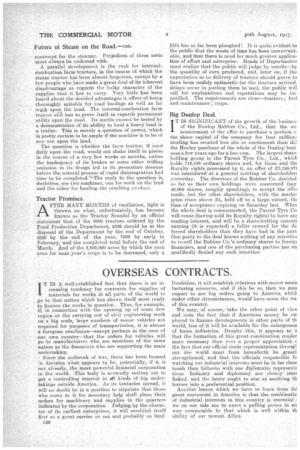Compressed Coal-gas an After-the-Peace . Development. .
Page 1

Page 2

If you've noticed an error in this article please click here to report it so we can fix it.
E HAVE on numerous occasions during the past 14 months examined the possibilities of using, compressed coal-gas. There is but one conclusion : the cheapest alternative fuel c-an only be used at atmospheric pressure for the duration of the war, except in those relatively few instances where prospective owners have rigid containers, or the material out of which to construct them, on hand.
The prospects for the continuing use of coal-gas after the peace are, in our considered opinion, by no means poor. Usiers of coal-gas in flexible holders, 'or example the engineer .to the Grimsby Street rrarnways Co., Ltd., have expressed the opinion, as a result of experience, that they will not return to petrol unless it falls to pr lower than 7d. per gallon, Are are not surprised at these decisions, and we think they are likely to prove of more general acceptance [II the near future. Free gas can already be obmined in Sunderland and a, few other places at is. ,er 1000 cubic ft. at the gasometer—the proved equiva ent of petrel at 3d. per gallon. Scores of towns in the lountry, under pre-war conditions, sold gas to large !onsturters at is. 4d. per 1000 cubic ft., whilst a few, n areas where coal, supplies and haulage rates on lie coal were favourable, 'sold it below is. per 1000 :ubie, ft.
It is clear • that, after the peace, with anything pproaching reasonable organization, compressed cal-gas (at 25 atmospheres) can be rendered availble to hundreds of owners of fleets of commercial iotors at an all-in-cost not exceeding the equivalent if petrol at 8d. per gallon. Some will command it t a cost equivalent to petrol at 5d. per. gallon. We ase our calculations upon the views of the Executive 'ionimittee of the British Commercial Gas Associaon, with the report of which committee we dealt in ur issue of the 9th August.
• The maximum cost of compressing coal-gas to 25 tantIspheres is Is. 4,d. -per 1000 cubic ft. of free gas, then using an installation with an output of 1500 hie ft. of free gas per hour, but this inclusive cost ails to 9d. per 1000 cubic ft. of free gas with an intallation having an output of 8200 cubic ft. of free as per hour: The eapital cost of the compressing lachirtery is 2275 or 2400, respectively.If coal-gas obtainable at 2s. 6d. per 1000 cubic ft.' of free gas, it same volume of gas after cOmpression to 25 atmos_ heres will on the average have Cost 3s. 6d. The petrol quivalents for this common rate of supply to an verage consumer are : uncompressed gas, 71(1. per anon; compressed gas (inclusive of interest on maintenance, wages, supervision, labour, and epreciation of plant), 10N. per gallon. There is, ierefore, a very considerable economy to be realized t respect of purchases of water-gas at rates per 1000 tubie ft. much in excess of 2s. 6d. We are sorry to find, in all existing circumstances, thata contemporary should in part base its unfavourable attitude upon incorrect data, reckoning the additional cost of compression to 25 atmospheres at the equivalent of from 70. to 100. per gallon of petrol displaced. This is more than 150 per cent. out. • Everything possible should be done to help forward 'the consumption of coal-gas. We have not failed to direct attention to the few relative disadvantages as compared with petrol, but we are pleased to know that) so far as working costs go, our original estimates . .
—as always—were on the high side. Many users are doing very much better than we forecasted, and are Much more satisfied with coal-gas than we had even dared to hope would be the case. Attention to detail is necessary, as with any adaptation or change of practice, but there are no real " snags."
Agrimotors for France.
THERE is a good deal to be said in favour of a scheme that has been approved by the French Chamber, under which large numbers of agricultural motors are apparently to be manufactured as quickly as possible after the war and put at the disposal of farmers on easy terms. The essence of the , idea. is the supply not only of machines, but of service depots where they can be maintained and repaired, and where spare parts will be available at a. reasonable price. Another feature that is worth noticing is that the scheme encourages a home manufacturing industry in preference to the hurried import of anything that can be got, and puts the products of that industry on to the market in such a way as to give them reasonable prospect of success. . The Future of Steam. on the Road.
IT WILL BE interesting, after hostilities are concluded, to see what, if any, effect on the relative . standing of steam and petrol lorries will result from the comparative lack. of interest taken by the military authorities in the former. One of the consequences has been to leave a good percentage of steam wagons in commercial service and to encourage people who had had their petrol vehicles commandeered to experiment with steamers, On the other hand, another effect will have been to educate an immense number of people in the idea that the petrol lorry is the one and only thing for hard service, and at the same time to train an immense number of drivers to handle Petrol vehicles. The motor owner very often sticks very faithfully to his first love, and when the war is finishedthere will be a lot of people coming back to take their share 'in the direction. of business concerns, whose first love will have been the petrol vehicle, and who will have cultivated a, kind of contempt for the steamer. Prejudices of these sorts must always be reckoned with. A parallel development is the rush for internaleombustion farm' tractors, in the course of which the steam tractor has been almost forgotten, except by a few people who have made aegreat deal of its inherent disadvantage as regards the bulky character of the supplies that it has to carry. Very little has been heard about the decided advantages it offers of being thoroughly suitable for road haulage as well as for week upon the land. The internal-combustion farm tractor still has to prove itself as regards permanent utility upon the road. Its merits cannot be tested by a demonstration of its ability to haul a heavy load in a trailer. This is merely a question of power, which is pretty certain to be ample if the machine is to be of any use upon the land. The question is whether the farm tractor, if used daily upon the road, would not shake itself to pieces in the course of a very few weeks or months, unless the inadequacy of its brakes or some other trifling , omission in its design led to its premature decease before the natural procees of rapid disintegration had time to be corripleted.'4The mealy to the question is, doubtless, use two machines, one for work on the land and the other for hauling the resulting produce.
Tractor. Promises. AFTER MANY MONTHS of vacillation, light is thrown on what, unfortunately, has become known as the Tractor Scandal by an official statement that of the 9000 tractors ordered by the Food Production Department, 2500 should be at the disposal of the Department by the end of October, 4500 by the end of the year, 7000 by early in February, and the completed total before the end of March. And of the 2,600,000 acres by which the corn area for next year's crops is to be increased, only a fifth has so far been ploughed! It is quite.evident to the public that the waste of time has been unwarrantable, and that there is need for much greater application of effort and enterprise. Heads of Departments must realise that the public will judge by results--by the quantity a corn produced, and, later on, if the expectation as to delivery of tractors should prove to have been unduly optimistic (or the tractors arrived, delays occur in putting them to use), the public will call for explanations and reputations may be imperilled. The requirements are clear—tractors ; fuel and maintenance ; crops.
Big Dunlop Deal.
IT IS S1GNIFICA.NT of the growth of the businese of the Dunlop Rubber Co., Ltd., that the an nouncement of the offer to purchase a portion c the share capital of the company for four million:sterling has created less stir or excitement than did the Hooley purchase of the whole of the Dunlop business a few years ago for a less sum. The largest shareholding group is the Parent Tyre CO., Ltd., which holds 712,468 ordinary shares and, for these and thE Royalty rights possessed by it, an offer of 2:3,159,87! was considered at a general meeting of shareholder yesterday. The directors of the Rubber Co. decided so far as their own holdings were concerned (say 40,000 shares, roughly speaking); to accept the offei made, but the other shareholders, with the inarkel price risen above 24, held off to a large extent, tin time of acceptance expiring on Saturday last. Whei the whole deal is consummated, the Parent Tyre Co will cease (having sold its Royalty rights) to have an trading interest, and will be a share-holding colleen earning (it is expected) a fuller reward for the de ferred shareholders than they have had in the past One party to the deal knows nothing of any intentiol to re-sell the Rubber Co.'s ordinary shares to foreigi financiers, and one of the purchasing parties has no qualifiedly denied any such intention






















